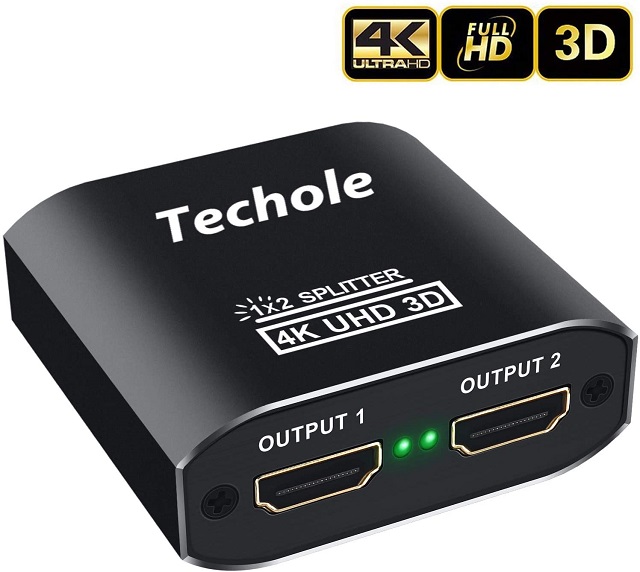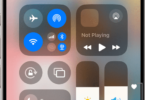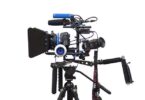HDMI Splitter is nothing but a small electronic device that split or distributes HDMI signal received from a source to multiple devices. It is different from HDMI Switch. For example, your HDMI Splitter can distribute the HDMI signal received from your Computer to multiple Monitors. With the help of a Splitter, you can distribute HDMI signal from your Blue Ray player to multiple televisions in different locations.
Technical Details about an HDMI Splitter and HDMI Cable:
Most common Splitters available in the market is “one to two” which means HDMI signal received from one source is delivered to two gadgets in different location via HDMI cable. 1×4 1×8 1×8 1×16, etc., are also available. These HDMI Splitters are full-featured HDMI v1.3b compatible for most of the 1080p and 3D support. The Splitters do not support Audio Return Channel and HDMI over Ethernet. HEC and ARC have the property that the source signal must be delivered to a single destination.
Generally, Splitters can be used up to 50 feet from the Splitter to the Television. It is advisable to restrict the distance between the Splitter and the TV to 25 feet for best results. If the distance is longer, then the signal strength will be reduced due to the specific resistance of the material used. For shorter distance, 28AWG cable will serve the purpose, but for longer the distance you need to use extreme high-speed cables, or Fibre Optic HDMI cables for best results.
The HDMI Splitter split the incoming HDMI signal and delivers it to the multiple HDMI output devices.
The HDMI cable consists of 19 pairs of wires that terminate the same number of pins on the HDMI plug. Each of the wire transmits Audio, video signals and other EDID commands specification of each device among them.
The Passive HDMI Splitter splits each of these paired wires into two or more sets that feed into HDMI jacks. The active HDMI Splitters have an external power source to compensate for the power loss due to split. For that reason, only the passive Splitters are standard 1×2 types. The active Splitter amplifies the input signal to compensate for the loss. And deliver it to the output component output devices.
How Do I Use My HDMI Splitter?
Suppose you are having a Blue Ray player and a television in the living room and another tv in your bedroom. Now you need to connect these two televisions with the blue-ray player. Since the blue-ray player comes with only one HDMI output port, you cannot connect both TVs with it. Here, the 1×2 HDMI Splitter helps you.
First, connect the HDMI output port of Blue-ray player with the HDMI cable connect the other end to the input port of the HDMI Splitter. Since the Splitter has two output HDMI ports, you need to connect the two TVs in the bedroom and living room to those output jack using HDMI cables. Both of the TVs will deliver the same full high definition picture with full surround sound that sent by the player.
What are the types of HDMI Splitters?
There are two types of HDMI Splitters:
- Passive Splitters
- Active Splitters
The HDMI Splitter receives HDMI signal from a single source and split it into two or more identical source and deliver them to the HDMI receivers without any loss of signal quality. Since the signals are digital, there won’t be much loss in quality.
The passive HDMI Splitters split the HDMI signal into two or more identical source. The passive Splitters are sufficient for most of the applications provided with minimum cable use.
The Active HDMI Splitters split the HDMI signal received from the source into two or more identical sources with an additional boost to compensate the signal loss due to splitting the signal or adjust the signal loss due to cable’s resistance. The Active HDMI Splitters best suited for those long cable runs involved.
HDMI Splitter vs HDMI Switch
There is a small confusion between HDMI Splitter and HDMI Switch. The Splitter splits the signal from a common source to multiple outputs. Whereas, HDMI Switch manage multiple HDMI source inputs to deliver it to a single source. Simply Splitter will transmit signals to all available channels, whereas the HDMI switch will transmit only one at a time.
Therefore HDMI Switch is a device that allows you to plug multiple HDMI inputs and deliver them via one HDMI cable to the destination.
Suppose your Television has only one HDMI input port and you need to connect your Blue-ray player, PlayStation 4, Xbox One and your cable network Then you need HDMI switch to connect all the four sources to your single source namely Television. Passive switches tend to have some signal lag when you play high definition games. Use of active switches can eliminate the lag, though they are costly. Keep it in mind active switches need an external power supply as that of active Splitters.
What is HDMI Hand Shake?
All the digital gadgets connected through HDMI use copy protection system called HDCP. When the digital components are connected, they talk to each other through the HDMI cable and verify the HDCP protocol. This verification is known as HDMI Hand Shake. During the HDMI handshake, the connected devices through the HDMI Splitter authenticate each other and verify each other is an HDCP device, among themselves.
They compute a secret key known as Extended Display Identification Data between them to send and receive the signal between them.
EDID (Extended Display Identification Data) is nothing but the Metadata transferred between the Splitter and connected devices during the HDMI handshake. During the HDMI handshake, the Splitter recognizes the capacity and limitations of the input and output devices connected.
The usage of HDMI Splitters has some disadvantages.
If the connected output devices are of different capacities, then the Splitter starts working in the lower capability.
The Limitations of HDMI Splitters:
- Suppose you two TVs connected with the HDMI splitter. One tv with 4K resolution and the other one with 1080p. During the handshake procedure, splitter identifies each of the tv’s resolutions with the help of EDID metadata, and it automatically drops the transmission to the lower resolution of 1080p when both of them switched on. When the lower resolution tv switched off or disconnected, the splitter automatically re-scan the destination and support the original higher resolution.
- If the signal converters such HDMI to VGA or HDMI to component Video connected between the HDMI Splitter and the output device, then it will not perform correctly. During the initial handshake process, the Splitter could not identify the resolution of the destination device because of HDMI to VGA or HDMI to component Video en-route them.
- The Splitter cannot function in reverse mode. If you have multiple HDMI devices and you are trying to connect them using a Splitter to your tv, they will not work. Simply the HDMI Splitter cannot function as an HDMI switch and vice versa.
- If you are connecting an HDMI Splitter with a 3D TV and an audio device, they may not function properly. During the handshake process, the Splitter identifies the output sources of different properties. Therefore because of conflict, they will not be supported.
- Suppose you are sending a 3D signal via HDMI Splitter to one 3D tv and another tv which is not 3D support or two 3D TVs of different technology and capability. In that case, the 3D signal drop to the lower level, which is supported by both of the 3D TVs, This issue not because of the Splitter but because of the HDCP copy protection rule strictly followed by the HDMI Splitter.
The features of HDMI Splitter:
The HDMI Splitters of all versions provide the following features.
- Support for concurrent output gadget delivery and usage- If you are connecting both TVs with Splitter which handshake successfully with HDCP (EDID metadata) protocol.
- 3D support for concurrent tv usage provided to both of the devices is of same 3D capability or same technology if any of the connected output devices not supported to 3D capability then it should be disconnected or switched off for getting 3d signals to the other 3D device.
- The Splitter supports DTS, Dolby Digital AC3, Dolby True HD and most of the other audio formats.
- The maximum distance between the HDMI Splitter and the Output device must be around 25 feet. Moreover, the use of HDMI cable between Splitter and the output device must be not more than 50 feet for a passive HDMI Splitter.
Frequently Asked Questions:
What is an HDMI Splitter?
HDMI Splitter is nothing but a small electronic device that split or distributes HDMI signal received from a source to multiple devices.
Do HDMI Splitter works?
Since the HDMI Splitters follow the HDCP handshaking protocol, they receive the same digital signal and deliver them to the multiple output devices without any loss.
Will an HDMI Splitter reduce the quality?
Since the signals are digital format, the Splitter will not reduce the quality. But in case of more output devices used the using Active HDMI Splitter is the best option.
What is the use of HDMI Splitter ?
The Splitter is a device that receives single digital input from a connected source and delivers the same to multiple connected displays without any loss.
Will HDMI Splitter work for two monitors?
Yes, the Splitter receives the HDMI signal from the source and split it into multiple HDMI signals. Therefore HDMI Splitter will work for two or more monitors.
Which HDMI Splitter is best?
An active HDMI Splitter is the best
How can I split my HDMI signal to multiple TVs?
First, connect the HDMI output port of Blue-ray player with the HDMI cable connect the other end to the input port of the HDMI splitter. Since the Splitter has two output HDMI ports, you need to connect the two TVs in the bedroom and living room to those output jack using HDMI cables. Both of the TVs will deliver the same full high definition picture with full surround sound that sent by the player.
How can I split my dish to multiple TVs?
First, connect the HDMI output port of Dish connection with the HDMI cable connect HDMI splitter. Since the Splitter has two output HDMI ports, you need to connect the two TVs in the bedroom and living room to those output jack using HDMI cables. Both of the TVs will deliver the same full high definition picture with full surround sound that sent by the player.







